Todd Klein's Blog, page 110
June 1, 2020
Incoming: THE NEIL GAIMAN LIBRARY Vol. 1
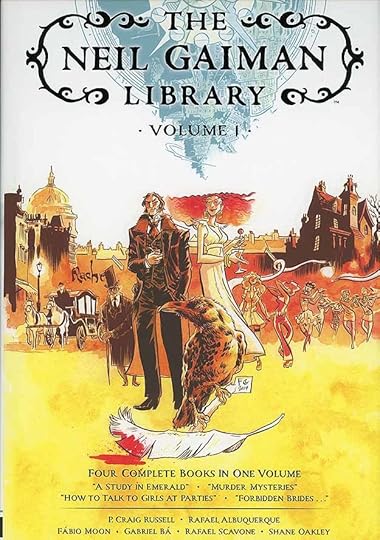 New cover by Fábio Moon
New cover by Fábio MoonJust arrived, a large, beautiful hardcover collecting four of the Neil Gaiman short story adaptations that Dark Horse has been publishing since 2001. The book style and format is just like DC Absolute Editions with excellent oversize reproductions of each page on thick, matte finish white paper. The only cost-cutting I can see is that the binding is glued rather than sewn.
I lettered two of these and own three, I look forward to reading the one I haven’t seen, “How to Talk to Girls at Parties.” There are ten books in the series that I know of, probably enough for three volumes if they include a few other things too. They’re all well done with excellent art, in this case by P. Craig Russell, Rafael Alguquerque, Fabio Moon and Gabriel Ba, Rafael Scavone and Shane Oakley.
Publication date is June 17. Highly recommended.
May 29, 2020
Rereading: THE BORROWERS ALOFT by Mary Norton
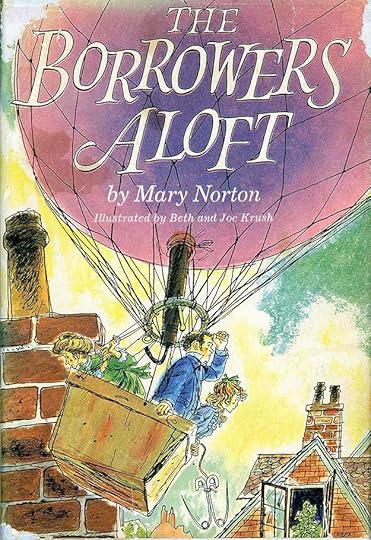
The fourth book in the charming Borrowers series, published in 1961, is framed differently than the previous ones. We have left behind Kate and Miss May. Instead we begin with retired railroad man Mr. Pott and his model railroad exhibit, for which he enjoys building an entire village. The railroad is open to the public, we heard about it in the previous book, The Borrowers Afloat, as a hoped-for destination for Pod, Homily and Arrietty, our family of tiny people. Miss Menzies is a friend of Mr. Pott who helps him with the exhibit and visitors, and she reports that one of the cottages in the village is inhabited, we know by whom. Once again, young Arrietty disobeys Borrower rules and begins talking to Miss Menzies.
Meanwhile, across the river, Mr. and Mrs. Platter have a rival model railroad, copying the idea from Mr. Pott, and enjoying the money they make from visitors. To keep up with his competition, Mr. Platter regularly spies on the Pott village from his boat, and when he learns of the tiny people living there, he’s sure his exhibit is all washed up. Unless, as Mrs. Platter suggests, they can steal the tiny people for their own village.
The Platters succeed, and make Pod, Homily and Arrietty prisoners in their attic while they build a house/prison for them to be used the following summer. Finally we learn how our Borrowers are handling all this (not well at first) and how they plan to escape. A clue is in the cover image above.
Just as enjoyable as the previous books, well written, with great characters and plot. This was meant to be the end of the series, but one more followed years later.
Recommended.
May 25, 2020
Rereading: THE BORROWERS AFLOAT by Mary Norton
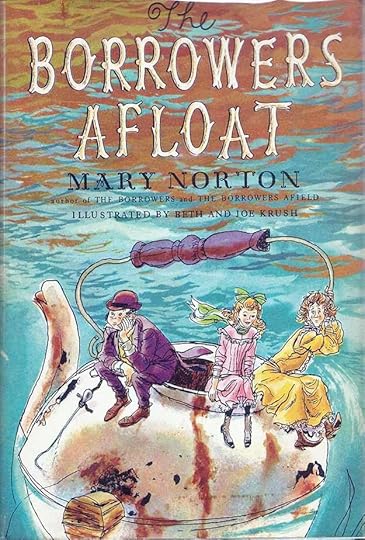 Cover illustration by Beth and Joe Krush
Cover illustration by Beth and Joe KrushThe third book of the charming Borrowers series, first published in 1959, begins like the first two with a framing sequence featuring Kate and Mrs. May, still visiting the cottage Mrs. May is buying, where Kate has been hearing about the Borrower family, father Pod, mother Homily and daughter Arrietty from old Tom Goodenough. Tom was the boy with the ferret in the first book, and lived in this cottage since his boyhood. At the end of The Borrowers Afield, Tom rescued the three tiny people from the gypsy Mild Eye, and brought them to this cottage, where their relatives, the Hendreary family, was already living in the wall.
Pod, Homily and Arrietty are at first warmly welcomed by their relatives, there are six of them, and given two sparse “rooms” to live in above the Hendreary home, but tensions soon rise, as Pod finds his borrowing curtailed, Homily’s old dislike of Hendreary’s wife Lupy returns, and Arrietty misses being outdoors. Arrietty once again turns to talking to the human Tom, something Borrowers are not supposed to do. In the end, their wild Borrower friend Spiller gives them a way to escape, and takes them to his home in an old teakettle at the edge of the nearby stream. For a while things go well until there’s a flood.
Just as much fun as the previous books, recommended. The illustrations are great, too.
May 22, 2020
And Then I Read: JIMMY OLSEN #10
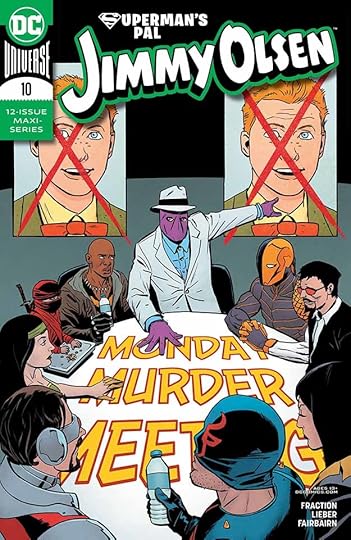 Image © DC Comics. Written by Matt Fraction, art by Steve Lieber, colors by Nathan Fairbairn, letters by Clayton Cowles.
Image © DC Comics. Written by Matt Fraction, art by Steve Lieber, colors by Nathan Fairbairn, letters by Clayton Cowles.It’s been a while since I’ve been able to enjoy this wacky series, and I’ve missed it. Jimmy continues to mire himself in all kinds of craziness and trouble, but in this issue we discover at least some of it isn’t his fault. Jimmy is apparently married to Jinx, an interdimensional jewel-thief, who in the opening segment is demoing her abilities on a live video with Jimmy to Perry White. Since she is not actually stealing jewels, he’s not impressed. Then a demon and an army of robots show up to claim Jinx, but can’t get past some bananas. A series of flashbacks fill us in on who’s really out to kill Jimmy and why, and then Jimmy decides he has to head out alone to fix things.
Great stuff, funny and clever in every way. Recommended.
May 18, 2020
And Then I Read: THE BLUE HAWK by Peter Dickinson

Peter Dickinson’s books cover a wide range of genres, styles and topics, but he can be depended on to craft a vivid world, fine characters, and a gripping story. This is no exception.
Tron is a young priest in an ancient kingdom resembling Egypt, but one where the gods they worship (unique to this story) have great power through their many priests and perhaps actual power as well. In contrast, the kings and other royalty have lost much of their power to the priests. As the story opens, Tron is at a ceremony of renewal for the King in the Temple of Gdu, his own sect, and he’s given a vision and task he feels is from the god Gdu. A Blue Hawk is on the dais with the King and priests. Tron has been designated The Goat, meaning anything he decides to do can’t be questioned. Tron leaves his fellows, goes up on the dais, and takes the Blue Hawk onto his arm and out of the temple. One consequence of this, he soon finds out, is that the King must die, as he overhears the head priests discuss how it will be done. Tron is troubled by this, but sure of his vision. Tron is tasked with training the Blue Hawk, and taken to a remote, empty temple to do that. He and the hawk bond, as they learn together.
While there, Tron meets the new King, son of the one he sent to death, and surprisingly, they become friends. The young King enlists Tron’s help in keeping his throne, and wresting power from the priests, in whom Tron has lost faith. He becomes the King’s secret partner, entering with him the hidden passages throughout the temples and palace. The King sends Tron on a perilous journey down the mighty river that waters the desert kingdom, and Tron barely escapes going over a giant waterfall at the southern border. When he and the Blue Hawk manage to climb out of the river canyon, he finds new friends in the mountains and learns his journey is only beginning.
Recommended.
May 13, 2020
And Then I Read: THE DREAMING #20
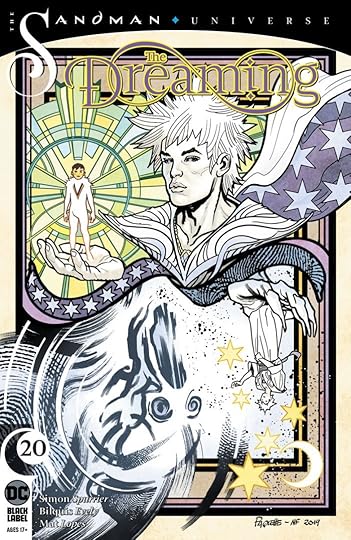 Image © DC Comics. Written by Simon Spurrier, art by Bilquis Evely,
Image © DC Comics. Written by Simon Spurrier, art by Bilquis Evely, colors by Mat Lopes, letters by Simon Bowland,
cover by Yanick Paquette & Nathan Fairbairn.
The final issue of this run of The Dreaming has finally arrived digitally. If you haven’t read the 19 issues that came before, there’s no point in starting here. If you have, I think you’ll find it a satisfying conclusion. As expected, writer Simon Spurrier has returned the main players to where he found them, but it’s been an enjoyable ride. His new character Dora gets a good send-off to adventures elsewhere, and the rest of the cast each have their moments. Dream himself is also at last on the scene once more. I’ve enjoyed the writing and art, particularly the art of Bilquis Evely, but everyone rose to the occasion including colorist Mat Lopes and letterer Simon Bowland. Nicely done all around.
Recommended.
May 10, 2020
Rereading: THE BORROWERS AFIELD by Mary Norton
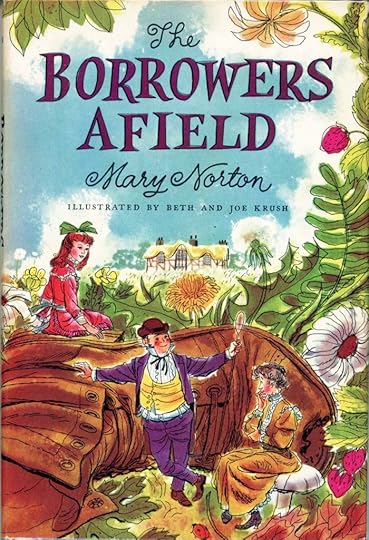
The second book in this charming series, published in 1955, opens with Kate and Mrs. May, from the framing sequence of the first book, traveling to the town where the Borrowers Pod, Homily and Arriety, tiny people who live in the walls and under the floors, had been seen many years earlier. They visit the house, but it’s a school now, and little remains of what had been there in Mrs. May’s youth when she had lasted visited. They’re in town because Mrs. May has been offered a cottage nearby, and she wants to see it. As it turns out, the elderly man living there, who is going to be moved to an almshouse, is Tom Goodenough, who was in the first book as the boy with the ferret. Kate makes friends with him, and he tells her what happened next to the Clock family of Borrowers.
Pod, Homily and Arriety have fled from their home under the kitchen floor of the big house, through the fields, following a path they know of along a gas line put in not many years before. It’s a world Arriety finds wonderful, but Homily, her mother, is full of fear, and Pod, her father, knows that fear is justified. Many wild animals might be happy to catch and eat them. At last they find an abandoned old boot, and decide to try living there. It’s summer, so there are fruits and grains to live on, and they do well enough at first. They meet a “wild” Borrower named Spiller who will tell them little about himself, but after some trouble with Homily, Spiller becomes a provider for them, and a friend to Arriety, and they have some adventures.
Fall turns to winter, and things look grim for the Clock family, as supplies dwindle and snow begins. Then the worst thing of all happens: a human finds their boot home and carries them off.
Just as much fun to read as the first book, and now it’s clearly a series. I also love the illustrations by Beth and Joe Krush. Highly recommended.
May 6, 2020
And Then I Read: THE PURSUIT OF THE PANKERA by Robert A. Heinlein
 Cover art by Scott Grimando
Cover art by Scott GrimandoJust when I thought every possible scrap of unseen material by one of my favorite writers had been published, this one turned up. It’s not a completely new book, but about two-thirds of one. Heinlein’s novel The Number of the Beast came out in 1980, and of course I bought it. Great illustrations by Richard Powers, but the book itself is probably my least favorite by the author. The new release is an earlier version, and is substantially different. It’s also better. NOTE: at the end of this post I will be comparing Pankera to Beast, so some spoilers will be unavoidable. Be warned.
The story opens at a posh party at the home of Hilda “Sharpy” Corners on the campus of a California university, a meet and greet for the four main characters, of which she is one. The book alternates narration by the four of them. First up is Zebediah Carter, her nephew, ex-military, who is dancing with beautiful D.T. Burroughs, and she’s trying to get Zeb to meet her father, scientist Jacob Burroughs. Deety thinks Zeb is the author of a scientific article her father is interested in, though Zeb explains it was written by another relative. Even so, Zeb and Deety are having a great time and he jokingly suggests they should get married. Deety quickly accepts, to Zeb’s surprise. Meanwhile, her father Jake is about to get into a fight with a rival professor, and Zeb, Deety and Hilda take him outside to cool off. As they’re about to leave, the Burroughs’ car is destroyed by a car bomb. Zeb, who has an intuition about danger, believes it’s no accident, and takes the four of them on the lam to the Burroughs’ hideway in Arizona, with a stop in Nevada for a double wedding. It seems that Jake is equally smitten with Hilda.
As the four get to know each other, a law officer arrives acting suspicious, and is killed by Zeb and Deety. It turns out to be an alien passing as human, and the four realize they are in great danger from these unknown assailants they call Black Hats. Jacob Burroughs has invented a machine that can travel in time and dimensions previously unknown, numbering six to the sixth to the sixth power (666, the Number of the Beast). Zeb and Jake fit this device to Zeb’s computer-driven car, Gay Deceiver, and the four of them embark on a series of adventures across time and space to first escape from, then turn the tables on their enemy, who come to be known as The Pankera.
Now as to the 1980 version versus the 2020 one. The four first go to Mars, where, in Beast there are rival military colonies from Russia and Britain. I hardly remember this long part of the original book, but glancing through it, it seems uninteresting now. In Pankera, the Mars they land on is Barsoom from the works of Edgar Rice Burroughs. It seems that some of the alternate realities include fictional worlds. About a third of the book takes place on Barsoom, and it’s pretty entertaining. Heinlein was obviously having fun revisiting old favorite stories. Another section, almost as long, takes place in the universe of E.E. “Doc” Smith’s Lensman series, another Heinlein favorite, and again fun to read. Between, there are brief visits to other fictional worlds, including Oz, the one section of the new book that’s almost the same as the old one.
Heinlein’s later works, like this one, have a number of problems for me and many readers. It’s too talky, and much of the talk is between the four main characters as they each display their competence and knowledge, vying for dominance in the group. It gets tiresome. There’s also plenty of sexual innuendo and naked people on Barsoom and beforehand that’s uncomfortable to read about today. Further, Heinlein used to be great at giving each character in a story a distinctive voice, making group discussions fun, see The Rolling Stones, for example. Here, even though all four narrate, the voice is almost the same in each case, and without checking, it’s hard to remember who is supposed to be narrating. Heinlein’s ideas about science are always interesting, but his group dynamics are more annoying than anything in this book. The action scenes, when they happen, are good, but there aren’t enough of them. One way this version is much better is the way the main plot about the Pankera is followed through to a satisfying conclusion, while in the original version it got sidetracked and lost.
Despite my reservations, this is a good read. I wouldn’t place it above anything he wrote before and including The Moon is a Harsh Mistress in 1966, but for his later work it’s not bad, and I did enjoy reading it.
Recommended.
April 28, 2020
Rereading: THE BORROWERS by Mary Norton
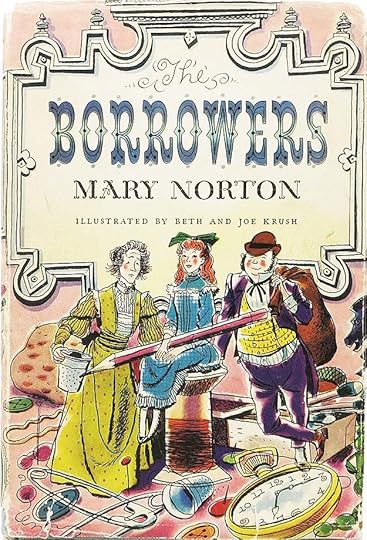
The first of five novels and a shorter book, Mary Norton’s charming fantasy was first published in 1952. The British edition was illustrated by Diana L. Stanley, the American edition, the one I grew up with, had wonderful illustrations by Beth and Joe Krush, as seen above.
The story is framed with a young girl, Kate, sewing with her Aunt May, who tells Kate about The Borrowers, tiny people who live in the cracks and crevices and inside the walls and floors of old houses, and who “borrow” all kinds of things, from food to a variety of small items to use as tools, containers, clothing, and decorations in their homes. In particular, Aunt May tells the story of a Borrower family, the Clocks, who lived in a home she visited as a child. Pod, the father, is the chief borrower, he goes out regularly to the main rooms of the house to gather. He’s getting older, and not as spry as he once was, but very wise in the ways of the “human beans” of the house and other dangers he might encounter. The owner of the house is an elderly woman, an invalid who lives in her bedroom. Beyond that there’s a cook and housekeeper and a gardener. Homily is Pod’s wife, a homemaker, and a clever one, though she is nervous and never satisfied with what she already has, always nagging Pod to bring her more “borrowings.” Their daughter Arrietty has always lived in their home under the kitchen floor, with only a small grate to view the outside world, and she longs to see and experience more. There were once many Borrower families in the house, but they have all gone, either “emigrated” to other places or disappeared in some way. Pod and Homily are vague about this with Arrietty.
Finally Arrietty is given a chance to begin learning to borrow, going with her father on his expeditions. Unknown to them, a boy has come to stay in the house temporarily while he recovers from an illness. The greatest danger to a Borrower is to be seen by a human bean, and before long the real trouble begins when the Boy sees Arrietty. She is not afraid of him, and they become friends of a sort, but the Boy causes all kinds trouble when he starts helping them borrow the contents of a dollhouse in his bedroom. Things only get worse from there for the Clock family. Will they have to “emigrate,” and try to find some of their long-missing relatives?
Great book, highly recommended. I’ve read them all a few times, and am beginning again. This kind of book is like comfort food for the mind in my case.
April 23, 2020
Rereading: (george) by E.L. Konigsberg

Konigsberg is a writer with an unusually wide range of topics. This, her fourth novel, delves into areas that were unusual and even shocking for kids’ books when it came out in 1970: split personality (perhaps) and drug use.
Ben Carr is a brainy student with a passion for chemistry, but he has a secret. Inside him is another person named (george), who is very different from Howard. (george) is wise about people and relationships, he speaks hard truths that sometimes even Ben doesn’t want to hear, and he looks out for both Ben and his little brother Howard, the only other person who knows about and can speak to (george). Usually (george) only speaks silently in Ben’s head, but when either of them are upset or determined to make a point, (george) can speak out loud in his own voice that’s deeper and different from Ben’s.
Ben has no other real friends, though he’s trying to win the friendship of William in Chemistry class at his high school. When equipment starts disappearing from that class, evidence points to Ben, who likes to take home any unused chemicals. Even their teacher, Mr. Berkowitz, suspects him, and comes to their house to speak to Ben’s mother, who is raising her boys on her own, having divorced their father. The unexpected thing that happens then is that Mr. Berkowitz and Mrs. Carr seem to be attracted to each other, and begin dating.
Ben and (george) are soon feuding over the missing lab equipment and Ben’s interest in William. When Ben and Howard go to visit their father for the holidays, Ben and (george) have an argument out loud that is overheard by Ben’s father and his new wife, who decide Ben is crazy, and must see a therapist. Ben returns home and does see one, but (george) is so angry with him that he won’t speak at all. What happens next between William and Ben, and what Ben and Howard decide to do about it, is a shock to everyone.
I liked this much better reading it now than I did when it came out and I was nineteen or twenty myself. I think I understand it better now, too. Recommended.
Todd Klein's Blog
- Todd Klein's profile
- 28 followers



